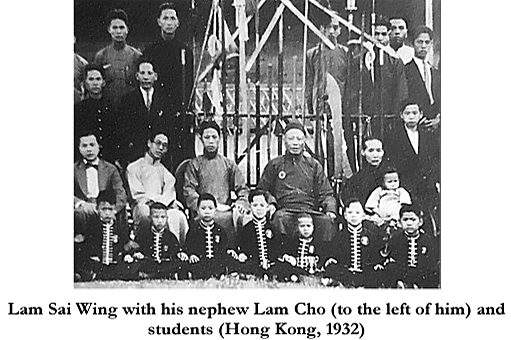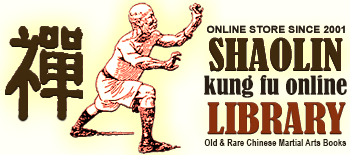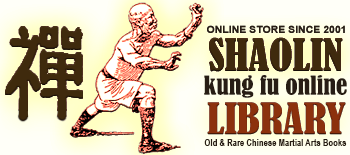
The quintessence of Southern Shaolin Kung Fu - classical Southern Shaolin Fighting Methods from the book: -"Black Tiger Claw" - "Fierce Tiger hiding in a cleft" - "The Bull strikes with its horn, makes a turn and breaches the sky" - "Hand of the Golden Dragon" - "To tear out a Phoenix's eye" - "Tiger striking with its tail" - "Two Dragons steal pearls" - "Snake raises up its head" - "Celestial Dragon wags its tail" - "Gold Dragon carries gifts in its claws" - "The Hand that calls out a Ghost" - and others...
"...This book will help to reach the mastership in Fighting Arts that are not simple to understand. It has been written with the aim of handing down the knowledge to disciples who are eager to find tutors and expect to receive instructions."
The book scrutinizes an old canonical form (Tao Lu) of Southern Shaolin Kung Fu, the "Taming the Tiger Fist" (工字伏虎拳, 'Gung Gee Fook Fu Kuen'). According to surviving sources, the founder of the Hung Gar style, Luk Ah Choy (陸阿采), studied this form under the tutorship of Southern Shaolin's best fighter, a Grandmaster of the White Tiger Style Southern Shaolin abbot Gee Sin Sim Si (至善禪師).
Lam Sai Wing.
Gung Gee Fook Fu Kuen. Moving Along the Hieroglyph GUNG, I Tame the Tiger with the Pugilistic Art (Hong Kong, 1957; First English Edition, 2002)
Bibliography: Lam Sai Wing
Payment Methods: Credit Card (Visa, Mastercard, American Express, Discover, etc.), ShopPay, PayPal, GooglePay.
We use Shopify Payments, a trustworthy payment gateway providing the best security. Shopify is certified Level 1 PCI DSS compliant. This means that we meet all six categories of PCI DSS requirements.
Shopify Payments is one of the most secure payment processors available, so you can shop with confidence.
The digital edition of the book (eBook in PDF) is an exact copy of the printed version. After you order, you will get instant access to download the eBook. You will also receive an email with a link to the download page.
Now Available: Second, Revised and Updated English Edition, 2025 >
The book scrutinizes an old canonical form (Tao Lu) of Southern Shaolin Kung Fu, the "Taming the Tiger Fist" (工字伏虎拳 , 'Gung Gee Fook Fu Kuen').

According to surviving sources, the founder of the Hung Gar style, Luk Ah Choy (陸阿采), studied this form (or Tao Lu, 套路) under the tutorship of Southern Shaolin's best fighter, a Grandmaster of the White Tiger Style Southern Shaolin abbot Gee Sin Sim Si (至善禪師).
Luk Ah Choy handed down his skills to Wong Tai. Wong Tai handed down his skills to his son Wong Kay Ying (黃麒英), who was one of the so-called Ten Tigers of Guangdong. Wong Kay Ying to his son Wong Fei Hung (黃飛鴻), who became a successor of the Southern Shaolin Martial Art in the fourth generation.
The author of the book, Lam Sai Wing, being Wong Fei Hung’s closest and most renowned student, represents the fifth generation of keepers of the Southern Shaolin heritage, or the fifth link in the chain of direct transmission of knowledge "from heart to heart," as Buddhists say.
...And the book truly embodies the spirit of Southern Shaolin. The book places a crucial emphasis on the fighting aspect of the techniques presented. The author details the techniques' key nuances, giving the movements combat content and meaning.
This book is an invaluable source of information for anyone interested in the martial arts of Southern China, and especially for practitioners of Hung Gar and other Southern Shaolin styles.
The Quintessence of Southern Shaolin Kung Fu - classical Southern Shaolin Fighting Methods from the book GUNG GEE FOOK FU KUEN:
-
"Black Tiger Claw"
- "Fierce Tiger hiding in a cleft"
- "The Bull strikes with its horn, makes a turn and breaches the sky"
- "Hand of the Golden Dragon"
- "To tear out a Phoenix's eye"
- "Tiger striking with its tail"
- "Two Dragons steal pearls"
- "Snake raises its head"
- "Celestial Dragon wags its tail"
- "Gold Dragon carries gifts in its claws"
- "The Hand that calls out a Ghost" and others...
Now Available: Second, Revised and Updated English Edition, 2025 >
About the Author

Lam Sai Wing
Lam Sai Wing (1860 - 1943) was born in the district of Nan Hai, Guangdong province. Followed the customs of ancestors and learnt the tradition of Martial Arts in his family, proceeded to learn from tutors Lam Fook Sing, Wong Fei Hung, and Wu Gum Sin. Indulged in persistent training, achieved great mastership in the Martial Arts. Founded Wu Ben Tang ("The Hall of Fundamental Study") in Guangzhou (Canton) where he taught the Martial Arts. During his life brought up more than 10,000 followers.
Toward the end of the Qing dynasty (1644 - 1911) gained the first place at large competitions that took place at the Dongjiao ground. Thanks to it, with great pleasure, Lam Sai Wing received a silver medal handed to him by Dr. Sun Yat-Sen himself as a token of the recognition of his great services and successes. In the years followed, taking images and characters of the Tiger and the Crane as a base, as well as techniques of Hung Gar Kuen and Fo Kuen styles, he founded a new school Fu Hok Seung Ying Kuen ("The Double Form of the Tiger and the Crane").
Lived in his old years in Hong Kong where he taught the Martial Arts together with his favorite disciples Juy Yu Jaai, Jeung Sai Biu, Lei Sai Fai, and others. Wrote books: GUNG GEE FOOK FU KUEN ("Taming the Tiger"), TID SIN KUEN ("Iron Thread Fist"), and FU HOK SEUNG YING KUEN ("The Double Form of the Tiger and the Crane").
Marked a new epoch and a new school of Chinese Martial Arts, in particular in the division of formal complexes Tao Lu. Fu Hok Seung Ying Kuen ("The Double Form of the Tiger and the Crane") is practiced on a large scale both in China and abroad and the interest to it does not fall down. After the formation of the People's Republic of China (1949) this style was included into syllabuses of institutes and Wu Shu high-grade schools.
/ An article from ZHONG GUO WU SHU ZEN MING CI DIAN - Dictionary "Well-known Masters of the Chinese Martial Arts" edited by Chang Cang and Zhou Li Chang. /

Short Historical Essay on Master Lam Sai Wing. Written by His Disciple Zhu Yuzhai
As related by Zhang Shibiao from Pangyu. The twelfth year Kuihai of the Peoples Republic (1923), the first month of the summer.
BOOK details
- Shaolin Kung Fu Online Library (USA, 2002)
- English
- PDF / 103 pages

GUNG GEE FOOK FU KUEN. A SHORT HISTORIC SKETCH by LAM SAI WING.
During the Qing Dynasty, in the years under the motto of Yongzheng (about 1723-1736), the Japanese army occupied the island of Taiwan. When the news about the Japanese seizure of some towns reached the Qing Government, it was terrified and sent the Chinese troops there to take back the island, but the Chinese army suffered defeat one after another. Military commanders of different ranks were not able to drive the Japanese away.
After that a detachment of monks from the Shaolin Monastery in Fujian province came to Taiwan. They, full of audacity and courage, delivered a decisive blow to the Japanese army. The Japanese suffered a defeat and retreated. Taiwan was liberated. The Qing Government rejoiced over the victory and intended to grant various titles and posts to the most courageous monks. However, the unworldly monks did not accept granted posts, so they were awarded with land allotments to grow rice and with other valuable presents.
The Qing bureaucracy thought that if there were such outstanding persons in the Shaolin Monastery, they might be dangerous for the Emperor Palace. If anti-Qing feelings become strong among the monks, it could be very harmful. The Qing Government sent to the monks grain and presents. At the same time some people sent by the government secretly brought to the walls of the monastery a lot of straw. One night broke out a fire that completely ruined the Southern Shaolin Monastery.
The monks who saved after the fire dispersed in different direction all over China like "stars in the sky". One of the most esteemed monks settled in the Haichuang Temple in Nanhai District near the city of Guangzhou (Canton). There he started to teach monks different methods of Fighting Arts. The most outstanding among his disciples was Luk Ah Choy, a monk who made a great success in learning. Luk Ah Choy handed down his skills to Wong Tai (Wong from the village of Louzhou in Nanhai district, small district of Xiqiao). Wong Tai handed down his skills to his son Wong Kay Ying, Wong Kay Ying to his son Wong Fei Hung who became a successor of the fighting arts in the third generation.
Later on, Wong Fei Hung taught the fighting arts to generals Wu Quanmei and Liu Yongfu. In the years under the motto of Guangxu (1875-1908) he won a contest and was nominated for a post of Jingxun Daqishou (something like an official person responsible for flood prevention). He served under the assistant of the governor of Fujian province Tang Jinsong. At that time riots of common people started in Fujien. The people of this province demanded that Tan should become the head of a democratic state and Wong Fei Hung - the commander-in-chief. That news made Li Hongzhang become the commander of the government army numbering several thousands of men to suppress the riots. Tang Jinsong could not resist such a large force and decided to hide after shaving his moustache and beard. Wong Fei Hung followed Tang. Both of them took a flight to Guangzhou (Canton). In Canton in Zienan street Wong Fei Hung opened up a drugstore named Bo Chi Lam. He lived in solitude there, he did not seek any posts and did not hand down his superb skills to outsiders.
This book will help to reach the mastership in Fighting Arts that are not simple to understand. It has been written with the aim of handing down the knowledge to disciples who are eager to find tutors and expect to receive instructions.






